Do You Have An FCR Strategy?
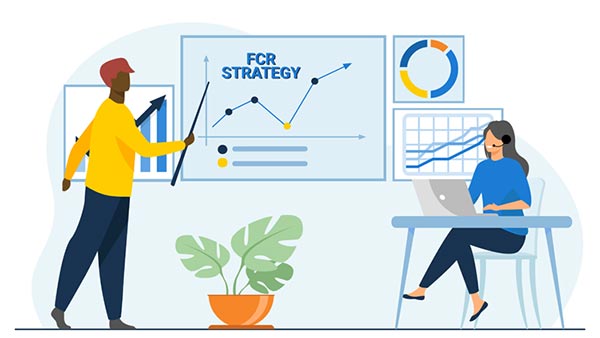
Does your organization have a First Call Resolution (FCR) Operating Strategy? Given that many contact center leaders consider the FCR metric to be the most critical metric for measuring cost and service, you would think most organizations have an FCR Operating Strategy. SQM’s experience is that the FCR Operating Strategy is limited to contact center leaders and seldom takes place at the enterprise-wide executive level.
The First Call Resolution or First Contact Resolution metric has been used primarily by contact centers to measure their agents’ ability to resolve a customers’ inquiry or problem on the first call or contact. The FCR metric has evolved into measuring email, website, IVR, and chat contact channels and has been used in contact centers for over 25 years.
Most organizational leaders view FCR as a metric that is only applicable to contact centers. Our view at SQM Group is that you can make a strong business case for using FCR as an enterprise-wide metric for which all employees at all levels are held accountable. However, the FCR metric does not apply to all organizations. For example, organizations that do not have a contact center or call volumes are low compared to other contact channels.
First Call Resolution Strategies for Improving Customer Experience
Many organization and contact center leaders struggle to define an FCR Operating Strategy and how to use it. At SQM Group, we have identified four distinctive FCR Operating Strategies based on two variants: FCR focus and FCR scope. These two variants can help an organization determine its competitive position for their FCR Operating Strategy they want to use in the marketplace. The FCR focus is based on either a customer experience (CX) differentiation or a lower-cost emphasis. The FCR scope is either enterprise-wide or a contact center level.
The four First Call Resolution Strategies are:
-
Contact Center with a Cost Focus
-
Enterprise-Wide with a Cost Focus
-
Contact Center using CX Differentiation
-
Enterprise-Wide using CX Differentiation
All four FCR Operating Strategies provide cost-saving benefits. However, a significant advantage in the CX differentiation strategy is being differentiated from the competition by delivering world-class FCR. Put differently, the CX differentiation strategy focuses on providing great customer service based on achieving high FCR versus a cost strategy that focuses on lowering operating costs based on improving FCR. The quad map infographic below illustrates the competitive position of First Call Resolution Strategies.
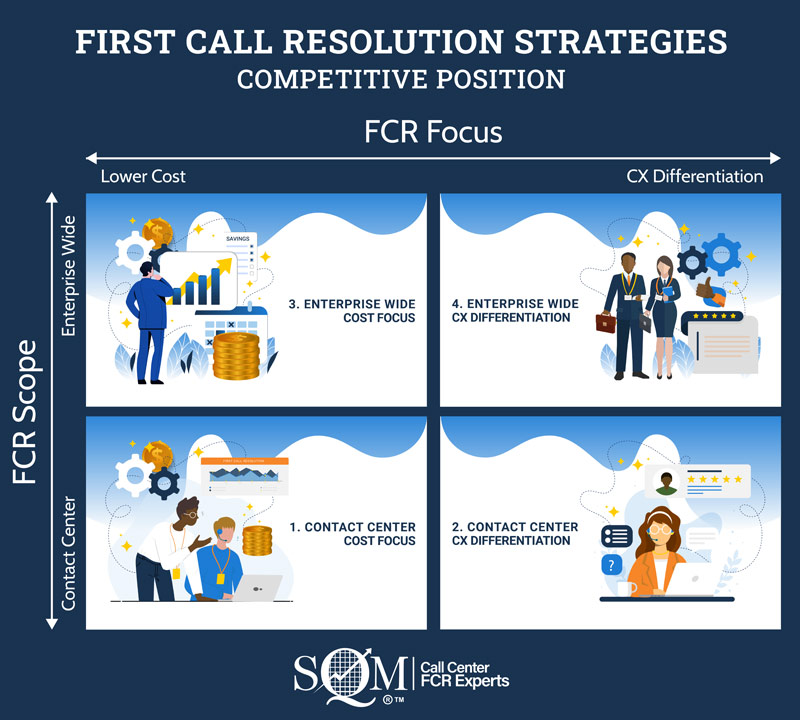
Legend
Contact Center = relates to this channel only
Enterprise-wide = relates to some or the whole organization
Lower Cost = involves cost per contact resolution
CX Differentiation = involves differentiating CX based on FCR
Most SQM clients start with a contact center lower-cost FCR focus strategy. Many clients continue to use a contact center cost strategy but evolve to using an enterprise-wide scope with a narrow (e.g., some departments or employees) focus strategy of lower-cost. The contact center CX differentiation strategy is the most used FCR Operating Strategy for SQM clients. Few clients use an enterprise-wide CX differentiation strategy based on an FCR focus because most C-level leaders have never considered FCR as an enterprise-wide metric, but at SQM Group, we think they should.
Each FCR Operating Strategy requires a different level of FCR commitment. CX differentiation requires the highest level of FCR commitment; conversely, cost focus requires the lowest level of FCR commitment. The specific actions required to implement a distinctive FCR Operating Strategy can be very different. Each strategy requires an FCR goal, accountability, and incentives for some or all employees. Whether the FCR scope is at the contact center or enterprise-wide level, the FCR focus can have a narrow (e.g., some employees) or broad (e.g., all employees) applicability.
SQM Group's research shows that for the contact center industry, the average FCR rate is 70%, which means 30% of customers have to call back the contact center to resolve their initial call reason. When we examined the source of errors (SoE) for non-FCR calls, we discovered that the customer was the SoE 13% of the time, an agent was the SoE 38% of the time, and the organization was the highest SoE at 49% of the time. Organizational SoE for non-FCR can be at the enterprise-wide or contact center levels. Each strategy option focuses on different root causes for non-FCR SoEs (i.e., customers, agents, organization) to reduce repeat calls.
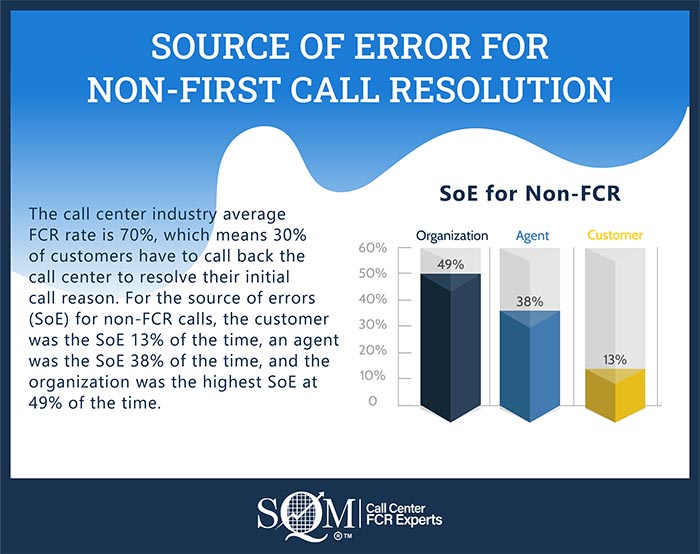
FCR Operating Strategies Description

Our experience shows that for many organizations that are new to measuring FCR, their FCR Operating Strategy starts in the lower-left quadrant at the contact center level with a cost focus. Many organizations that use a contact center scope with a cost focus strategy do it because FCR is a widely used metric for measuring and improving operating costs and is a low-risk strategy. This strategy includes FCR goals, accountability, and incentives for contact center managers at all levels. To improve FCR, contact centers that employ this strategy tend to focus on non-FCR organizational (e.g., policies, procedures, technology issues that they control) source of errors for reducing repeat calls. For this strategy, FCR is typically measured at the line-of-business level versus at an agent level.

Alternatively, organizations can evolve their FCR Operating Strategy to the upper left quadrant to expand their FCR scope outside of the contact center to include some departments or employees and move to an enterprise-wide narrow cost focus. An enterprise-wide narrow cost focus includes FCR goals, accountability, and incentives for specific departments and employees outside the contact center where the FCR metric is applicable. This strategy can be very effective because specific departments or employees (e.g., claims department, field services) play a significant role in helping the contact center improve operating costs by delivering FCR. To improve FCR, organizations that employ this strategy tend to focus on organizational (e.g., policies, procedures, technology issues that they control) source of errors for reducing repeat calls. For this strategy, FCR is typically measured at the line-of-business level versus at an agent level.

At SQM, most of our clients' FCR Operating Strategy is in the lower right quadrant based on a contact center scope, with the FCR focus being a CX differentiation. The CX differentiation FCR focus includes FCR and call resolution goals, accountability, and incentives for all contact center employees (e.g., managers, support staff, and agents). This strategy requires a high commitment for measuring and improving the First Call Resolution rate. For this strategy, FCR is typically measured at the line-of-business and agent levels. Most SQM clients hold managers and support staff to FCR goals and hold agents to call resolution goals, creating more line of sight accountability. It is common for organizations that employ this strategy to have their contact centers improve FCR year after year or maintain world-class FCR performance.

We have clients with an FCR Operating Strategy in the upper right quadrant based on an enterprise-wide scope, with the FCR focus being CX differentiation. Clients using this strategy also have the contact center CX differentiation strategy in place. Interestingly, for organizations with an FCR Operating Strategy at the enterprise-wide level, FCR, customer satisfaction, and transactional Net Promoter Scores® are among the highest of the 500 contact centers we benchmark. These organizations treat FCR as more than just a metric; FCR is an operating philosophy at all levels within the organization. This strategy requires the highest commitment level of all strategic options for measuring and improving the First Call Resolution rate. For this strategy, FCR is typically measured at the line-of-business and agent levels. However, the main advantage of this strategy is that all employees are accountable for the FCR rate. To improve FCR, organizations employing this strategy focus on non-FCR organizational and customer sources of errors at the enterprise-wide level. At the contact center level, the emphasis is on the non-FCR agent source of error.
Business Case for using FCR as an Enterprise-Wide Metric
The First Call Resolution metric should be viewed as an FCR balanced scorecard metric because it measures efficiency and effectiveness. In addition, using a VoC FCR approach can be considered to be an outside-in versus inside-out approach. The essence of the Outside-In CX operating practice is based on the customer perspective. Customer feedback is used for designing people, processes, and technology practices to meet the customer’s needs.
FCR impacts operating cost, customer satisfaction, and Net Promoter Score at the enterprise-wide level. Now let's look at the business case data for making FCR an enterprise-wide metric.
The Cost of non-FCR Calls
The below figure shows the cost of non-FCR calls. The data reveals that the average call center resolves 70% of their calls on the first call. This means that 30% of customers have to call back because their issue is not resolved on the first call. The number of repeat calls made to resolve a customer’s initial inquiry or problem, for the average call center that SQM benchmarks, is approximately 540,702 representing 26% of the annual call volume, costing the average call center about 4.8 million dollars per year. In most cases, world-class FCR contact centers’ repeat calls are only between 10% and 15% of total call volume. You can make a legitimate argument that the FCR rate reflects an enterprise’s operating cost efficiency from a customer perspective.
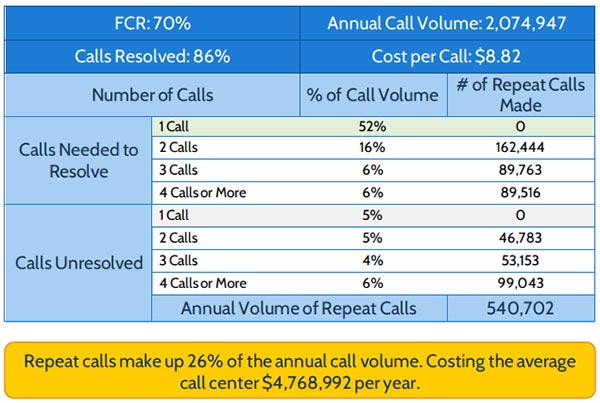
The improvement of FCR at the enterprise-wide level leads to operational savings of at least five times greater than that of the cost savings opportunities at the contact center level. The increased cost savings at the enterprise-wide level are due primarily to reducing customer defection costs by improving the FCR rate. The below figure shows that only 1% of customers expressed their desire to stop doing business with a company when First Call resolution is achieved. However, when it took two or more calls to resolve an inquiry, 4% of customers expressed defection, and an alarming 22% of customers expressed defection if their call was unresolved.

First Call Resolution Impact on Enterprise-wide Customer Satisfaction
First Call Resolution positively impacts call center and enterprise-wide customer satisfaction (Csat). SQM Group's research shows that for every 1% improvement in FCR, there is a 1% improvement in call center customer satisfaction. Furthermore, our research shows that on average, Csat (top box response) drops 15% every time a customer has to call back to resolve their initial call.
The below figure shows the impact that FCR has on enterprise-wide Csat. When FCR is achieved, Csat is 78%, and when repeat calls are required to resolve an inquiry or problem, Csat drops to 64%. However, if the call is unresolved based on only one call, Csat drops to 46%. However, what is truly alarming is if an inquiry or problem is unresolved based on two or more calls, Csat drops to a dismal 29% level. The absence of FCR is a strong driver of enterprise-wide customer dissatisfaction.
Most organizations or call centers do not track if a customer transaction in doing business with an organization is unresolved from a customer perspective. Given the enormous negative impact that unresolved calls have on Csat, there is a tremendous opportunity to measure FCR and call resolution more effectively from a customer’s perspective to determine call center and enterprise-wide Csat impact.
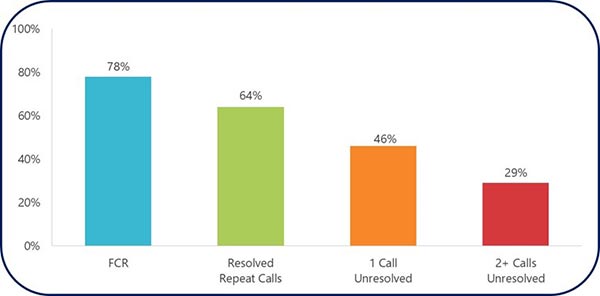
First Call Resolution Impact on Transactional NPS®
First Call Resolution positively impacts transactional Net Promoter Score (NPS®). SQM Group's research shows that every 1% improvement in First Call Resolution increases transactional NPS® by 1.4 points for the average call center. FCR and transactional NPS have a statistical correlation of .64, which would be considered high and shows that FCR positively impacts transactional NPS.
Many contact center leaders believe that transactional NPS is not an appropriate metric because they have no control over enterprise-level pricing, policies, products, and promotions. Conversely, many non-contact center employees believe that FCR is not a relevant metric because they have no control over contact center operating practices. But is that the correct way to view the FCR metric?
For many organizations, the contact center is the primary contact channel customers use to interact with them. Suppose your contact center is the main contact channel customers use. In that case, you should consider making FCR an enterprise-wide metric that all employees at all levels are accountable for the First Call Resolution rate. However, as previously mentioned, FCR is not applicable as an enterprise-wide metric to hold all employees responsible for an organization that does not have a contact center or call volumes are low compared to other contact channels.
The below figure shows SQM's call center research for FCR, Repeat Calls, and Calls Unresolved impact on transactional NPS. The data reveals that when customers experience FCR using a call center, the NPS is 64 points. When an inquiry or problem Call was Resolved, but it took repeat calls, the NPS drops to 40 points. When one call took place, and the Call was Unresolved, NPS goes down to -10 points. However, what is most alarming is when two or more calls took place, and the Call was Unresolved, NPS is -38 points. Clearly, FCR is a driver for improving transactional NPS.
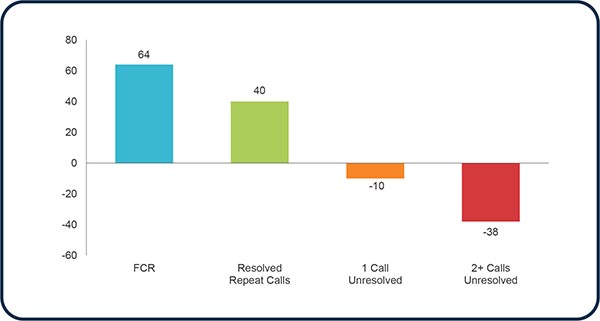
In Closing
Developing and implementing a First Call Resolution Operating Strategy requires strategic leadership. Leaders and teams enact strategic leadership when creating the competitive position, alignment, resources, and commitment needed to achieve the enterprise's enduring performance potential. To achieve enduring performance potential, organizations may need to transform business practices, and therefore, strategic leadership requires successfully navigating and leading these transformational organizational changes.
Quick Related Links
First Call Resolution Definition First Call Resolution PPT First Call Resolution Benefits
First Call Resolution Strategies First Call Resolution Operating Philosophy FCR Case Study Survey Data Calculate First Call Resolution Rate What is a Good FCR Rate? CX Pulse Check VoC Closed-loop Top 10 CX Metrics FCR Enterprise-Wide Metric Outside-In of Inside-Out


